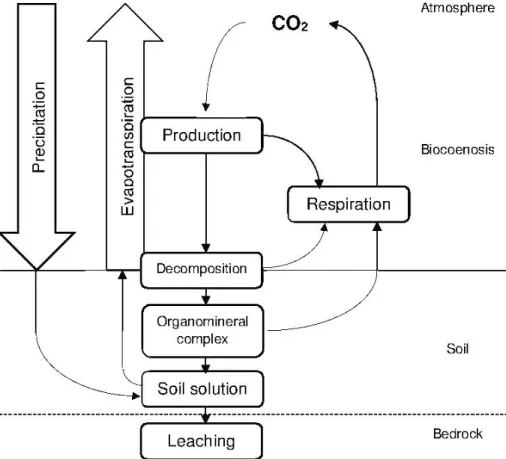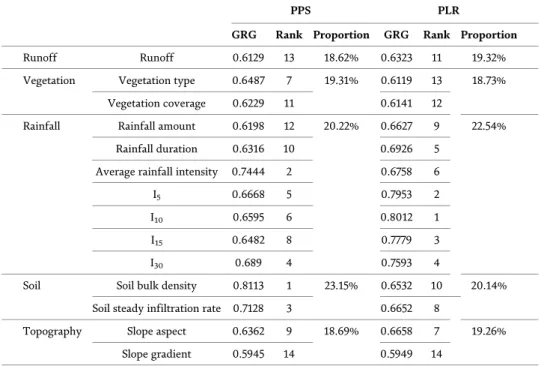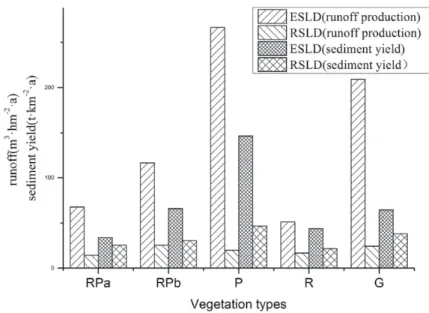While the soil moisture potential decreases with the help of the tensiometer and greatly saves the irrigation water. Therefore, the delineation of the soil moisture potentials and moisture balance components is important to improve both land and water productivity; it improves social security in the water-poor regions of the world.
Soil moisture potential ( ψ W)
- Hydraulic potential
- Matric potential ( ψ m)
- Pressure potential
- Gravitational potential
- Osmotic potential (ψs)
In a natural soil environment, the movement of soil moisture is mainly determined by the hydraulic potential (ψh), the total moisture potential. The greater the adsorption forces, the greater the matrix potential and thus the water is less free.
Soil moisture balance computation
- Rainfall (R)
- Irrigation water amount (I)
- Evaporation (E)
- Drainage (D)
- Seepage (S)
- Change in profile moisture (ΔG)
The necessary correction factor must be applied, which is the case with the heavy rainfall if the rain gauge cylinder overflowed [39]. S is the lateral water flowing from one side of the dams to the other, which could change the amounts of water used.
Conclusion
Among the various degradation processes, soil erosion is one of the serious threats to the degradation of soil and water resources. Therefore, holistic management of land and water resources is indispensable for the sustainability of agriculture as well as for the protection of the natural ecosystem.
Introduction
Development and adoption of improved technologies, judicious use of natural resources and effective management practices are the need of the hour for the protection of land and water from degradation. The judicious use and management of land and water resources is now more important than ever before to meet the needs of the ever-growing world population [9].
The extent of land degradation
On the other hand, the future of living beings and agricultural production systems is at risk due to the continuous depletion of aquifers and increased pressure on groundwater under projected climate change scenarios [7]. Therefore, under the evolving scenario of acute water scarcity and land degradation, we must focus our efforts on developing and adopting efficient approaches for soil and water conservation and agricultural sustainability.
Soil Erosion and erosion causing agents
Soil erosion is the removal of topsoil by the physical forces of erosion agents at a greater rate than the rate of its formation. In contrast, the rate of soil erosion exceeds a certain threshold level in accelerated erosion and becomes rapid.
Water erosion
- Splash erosion
- Sheet erosion
- Rill erosion
- Gully erosion
- Ravine formation
- Tunnel erosion
- Slip erosion or landslip erosion
- Stream bank erosion
- Coastal erosion
- Universal soil loss equation for water erosion
Precipitation is one of the main factors causing the movement and loosening of soil particles. Splash, leaf, stream and gully erosion are the main forms of soil erosion by water (Figure 1).
Impact of soil erosion on agriculture
Among the above factors, the vegetation and to some extent soil can be controlled to reduce the rate of soil erosion, but the climatic and topographical factors, except the length of the slopes, are not controllable. Soil loss through water and wind has serious consequences for the productive efficiency of all ecosystems.
Soil and water conservation measures
Biological measures (agronomic/agricultural and agroforestry)
Agronomic measures reduce the impact of raindrops by covering soil surface and increasing infiltration rate and water absorption capacity of the soil leading to reduced runoff and soil loss through erosion [39]. Intercropping provides better coverage on the soil surface, reduces the direct impact of raindrops and protects soil against erosion [36, 43].
Mechanical measures
In the middle of the dam, an overflow is provided to safely discharge the drainage water [21, 60]. Soil dug out of the drain should be dumped at the bottom of the drain.
Conclusion
Check dams are effective for preventing severe runoff and erosion in steep and wide gullies, and are best suited for high-elevation areas of the watershed [62]. Branches of tree and shrub species are placed in two rows parallel to each other, filled with brushwood and stretched across the mouth or stream path.
Future perspectives for soil and water conservation
Emphasis on research, education and extension of soil and water conservation efficient technologies to the stakeholders. ICRISAT International Crops Research Institute for Semi-arid Tropics IISWC Indian Institute of Soil and Water Conservation.
Soil water and its relation to the soil environment 1 General characteristics of soil water
Hydric functions of forest soils
This is why soil carbon storage irreplaceably increases the WHC of the entire ecosystem. This can be further related to weighted averages of soil types as found in the Harmonized World Soil Database (HWSD) [59]. The hydrographic zonation of forests shows differential efficiency of forests in modifying the local water cycle.

Soil water and its relationship with groundwater
The long-term fall of the soil water level with high evapotranspiration can lead to the floodplain forest being replaced by the forest-steppe [65]. The protection of the water retention capacity of the watershed mainly consists of the predominance of contiguous forest areas. The soil and rock environments can be divided into two zones in terms of the saturation of the environment with water.
The soil-forest-water-civilization nexus .1 The elements of life
But over the past 150 years, we've lost 50% of the planet's topsoil to soil erosion. But deforestation is one of the main causes of the erosion crisis facing the planet. In the Murray Darling Basin, 63% of the forested area has been converted to cropland over the past 200 years [92].
Conclusion
Of greater concern is the fact that such extensive changes due to deforestation and destabilization of the soil-water relationship may lead to regime shifts. Of the total water sources, the most demanding is agriculture and the water used for irrigation for 68%. Its content in the soil changes constantly and depends on weather conditions and the needs of the plant world.
Chemical and physical water properties
Due to the movement of water in the soil and the variable content, there are two major problems. One of the basic functions of water in a plant is derived from this fact, and that is regulating the temperature of the plant (thermoregulation) [10]. Surface tension plays an important role in the transport (movement) of water in the soil-plant system.
Water uptake and movement trough the plant 1 Basic process of water uptake
Water chemical potential
The positive value of the suction force corresponds to the negative value of the water potential. Plant cells between the saturated state and the withered state have a suction force corresponding to the negative value of the water potential. A large difference in the water potential gradient of plant leaves and the atmosphere causes transpiration.
Plant water balance water status
Water will enter the cell until the water potential inside the cell equals that outside the cell. The flow of water into the cell due to the water potential gradient causes a hydrostatic pressure (turgor) in the vacuole. Similar happens when water enters the root of plants, through the apoplast where the driving force is the difference between the water potential of the xylem and the soil solution.
Absorption, transport, and transpiration of water
Osmoregulation is the adaptation of osmotically active substances in the cell to new environmental changes that mainly control the water potential of the cell. Negative hydrostatic pressure develops on the surface of the cell walls below the stomata due to water loss through transpiration. Plants pass most of the water over the stomata and release the water in the form of water vapor.
Plant adaptation to the soil moisture regime
The mechanism for opening and closing the stomata works based on the water and osmotic potential of the gate cells. Timing of opening and closing of stomata serves to maximize photosynthesis and minimize transpiration. There are plants that grow on land with very little water supply and where the plant faces drought for most of the year.
Soil moisture sources
Soil water type
Moisture from the soil is a much more favorable factor influencing the uptake and use of water in the plant than the moisture the plant receives through precipitation [42, 43]. Hygroscopic water in the soil is kept under a high pressure of 50 bar; since the suction of the root system is between 6 and 16 bar, it is inaccessible to plants. Free water in the soil is in the following forms: gravity, groundwater, and icy water.
Movement of water in the soil
Capillary water is the water that fills the narrowest pores of the soil due to the action of surface tension and occurs by increasing soil moisture. Confluent water is the water that is in the surface layer of the soil and is held by the forces of molecular interaction between the soil particles and the submerged water. In such a saturated state, water seeps through the macropores by gravity and does not bind to the soil.
Soil water constants
The double Mitscherlich hygroscopic value corresponds to the equilibrium state between the suction force of the plant root and the soil particles, which is called the wilting point. An excess of water in the soil causes problems in supplying the plant with oxygen (the occurrence of anoxia = a complete lack of oxygen and the occurrence of hypoxia = a reduced amount of oxygen). Field capacity corresponds to the state of moisture that occurs in the soil immediately after rain, before evaporation and transpiration begin.
Drought stress
Mechanisms of plant adaptation to drought
Hydroactive retention of the stoma occurs as a result of a decrease in osmotic potential, which leads to the release of water and a decrease in turgor in the guardian cells. As the amount of water in the soil decreases, the water potential of the soil decreases. The response of the plant to stressful conditions was in most cases reflected in the unfavorable status of water in plant tissues and organs.
Process of soil salinisation
Soil salinity is a growing threat around the world due to its toxic effect to reduce soil fertility and water uptake in crops. The salinity causes the reduction of nutrient ions and the uptake of water has a significant negative effect on crop yields. Interactions between soil and water salinity and their influence on crop growth and salinity management are discussed in this chapter.
Measure of analysing soil salinity
Saturation extract (ECe)
Hydrological factors such as a high annual moisture flux, climatic factors such as low precipitation and high temperatures increase evaporation and geomorphological factors such as low relief are the cause of primary salinization [3–5]. Secondary salinization due to shallow water, poor quality irrigation water, excessive irrigation with improper drainage raises groundwater levels and releases salt near the soil surface, excessive use of groundwater in coastal areas causes seawater intrusion. Finally, untreated industrial wastewater and wastewater with a high content of dissolved salts are the reasons for secondary salinization [6–9].
Ranges of soil salinity
Irrigation water salinity
Salinity effects 1 Effect on plant growth
Effect on soil fertility
Conductivity depends on the concentration of the ions in the solution, temperature, valence and length between two electrodes. The conductivity is directly proportional to the concentration of the solution, solution temperature and valence and inversely proportional to the length between two electrodes [10]. The uptake and assimilation of potassium influenced by the Na/Ca ratio causes a reduction of the K/Na ratio of the plant [19].
Saline soil management
- Periodical monitoring and assessment by salinity mapping
- Physical management of saline soil
- Chemical method
- Bio remediation of saline soil
China is one of the countries with the most severe soil erosion in the world. Shaanxi Province is one of the most serious areas of soil erosion in the world. Few researchers have studied the relative weight of the four main factors controlling runoff and sediment yield.
Materials and methods
- Study area
- Experimental design
- Measurement
- Meteorological data
- Soil bulk density
- Soil steady infiltration rate
- Data processing
However, the effects of natural rainfall events on runoff and sediment yield were found to be very different with artificial rainfall simulations [22]. Furthermore, few works in the literature focused on the weights of different factors on runoff and sediment yield during the soil disturbance process. Relational gray grade between runoff and sediment yield and factors affecting runoff and sediment yield.
Results
- The relationship between rainfall amount, rainfall-runoff, and sediment yield
- The factors affecting runoff and sediment yield based on gray relational analysis
- Factors affecting runoff
- Factors affecting sediment yield
- Runoff and sediment yield under different vegetation types
The effects of vegetation type and vegetation cover on sediment yield were reduced according to the GRG analysis. Significant differences were observed between the treatments in terms of runoff and sediment yield during PPS and PLR (Figure 6). The runoff and sediment yield during PPS was remarkably greater than during PLR, especially for P.

Discussion
- Relationship between rainfall amount, rainfall-runoff, and sediment yield Rainfall, vegetation, soil, and topography are the main factors involved in soil
- Effects of land disturbance and restoration on runoff
- Effects of land disturbance and restoration on sediment yield
- Influence of vegetation type on runoff and sediment yield
However, the ranking of the effect of rainfall intensity on runoff and sediment yield in most years was I30, I15, I10 and I5. The weights of the studied factors on sediment yield differed significantly between PPS and PLR. P>G>RPb>RPa>R; the order of vegetation types for the production of sediment yield was P>RPb>G>R>RPa.
Conclusion
Effects of precipitation and restoration vegetation on soil erosion in a semi-arid environment in the Loess Plateau, China. The effect of land uses and rainfall regimes on runoff and soil erosion in the semi-arid loess hill area, China. Effects of land use on phosphorus loss in the hilly area of the loess plateau, China.
